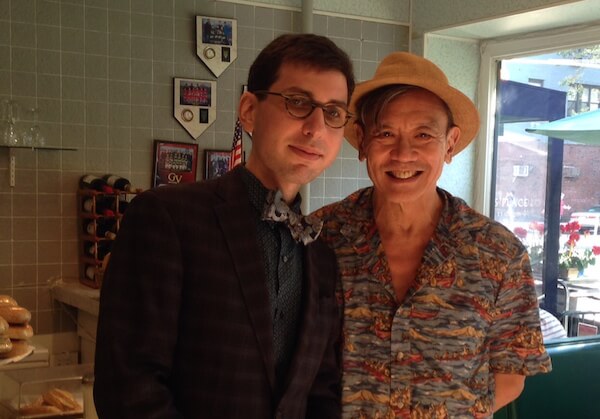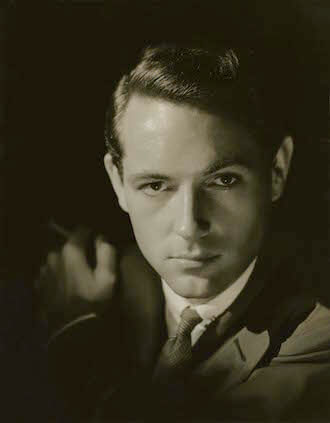Sophie Tucker with Ted Lewis in 1934. | MENEMSHA FILMS
From birth to age 18, a girl needs good parents. From 18 to 35, she needs good looks. From 35 to 55, she needs a good personality. From 55 on, she needs good cash.”
There were show biz originals, and then there was Sophie Tucker (1887-1966). Porcine-faced and decidedly stout, Tucker was, even as an older lady, one of the most enduringly popular entertainers of the last century. With her white hair teased up into outrageous proportions, sometimes approximating a huge snowy bow, draped in blinding sequins, she would shake an imposing finger at her audience and, in her stentorian baritone, crack hysterically bawdy jokes and half-sing and speak songs like “Life Begins at Forty,” “I’m Living Alone and Like It,” “Nobody Loves a Fat Girl, But Oh How a Fat Girl Can Love,” and her great signatures, “My Yiddishe Momme” and “Some of These Days,” slaying audiences everywhere.
Apart from Tucker’s unmistakable impact on Bette Midler’s art dating back to the 1970s, she is largely forgotten today, except by seniors and, of course, gay men enamored of all things show. But this protean talent, incredibly shrewd business woman, and complex personality who encompassed both endless charity and monstrous ego, is finally getting her real due in the documentary “The Outrageous Sophie Tucker,” directed by William Gazecki and the brainchild of producers Susan and Lloyd Ecker. It’s a loving, wonderfully revealing tribute, laced with delightfully pungent interviews with Carol Channing, Tony Bennett, Bruce Vilanch, Kaye Ballard, Michael Feinstein, Barbara Walters, Shecky Greene, and a raft of others.
A world-class entertainer finally gets her due & three other super summer movies
I met the Eckers, who describe themselves as the world’s foremost authorities on Tucker “by default.” They are parlaying their obsession with the lady they describe as the “Forrest Gump of the first half of the 20th century” — she knew simply everyone and mentored the likes of Mae West, Judy Garland, Frank Sinatra, and Jerry Lewis — into a series of biographical volumes and a Broadway musical. The film opens July 24 at Cinema Village (22 East 12th Street; cinemavillage.com) for three weeks and, in appropriately Sophie-vaudeville style, the couple will be there at every screening to conduct a Q&A afterwards. (Judy Garland biographer John Fricke will join the Eckers following the 8:45 p.m. screening on July 24. The film is also screened at JCC Manhattan beginning this week and beginning July 31 at locations in Queens, Long Island, and New Jersey; menemshafilms.com/outrageous-sophie-tucker).
Sophie Tucker with Judy Garland in “Broadway Melody of 1938.” | MENEMSHA FILMS
Susan started things off by saying they had been working on this project for nine years, but then amended it: “It actually started in 1973 when we were in Ithaca College together on our very first date. Lloyd was the big man on campus, in charge of organizing the concerts. He got a call from this promoter who had a cancellation and said, ‘This is a new singer. Do you want her?’ He said, ‘I guess so,’ although her name didn’t really register with him. There I am, sitting in the front row and he says right before concert starts, ‘I’ll be right back,’ and I’m thinking, ‘Oh God, what kind of date is this?’ Next thing I see he’s on stage when the lights came up saying ‘Okay, everybody let’s give a warm welcome to Miss Bette Midler!’ And then we had dinner with her backstage after the concert, so I thought, ‘Okay, I’ll go on a second date with him. He’s not such a schlump.’ She did all this Sophie Tucker shtick and, oh, she had a piano player too with her, Barry Manilow, and we were all eating spaghetti together.
“We got married, had three kids, they went off to college, and we were like, ‘Okay, what should we do?’ Lloyd sold our Internet business to a public company and came home with a check. I said, ‘First, I’m gonna put that check into my account.’ I had been living with an entrepreneur for 30 years, and I wanted some stability. He asked me what I wanted to do, and I said, ‘I want to have dinner with Bette Midler again. That would be fun.’”
Lloyd jumped in at this point: “I said, ‘I have a better idea. Why don’t we find out who this Sophie Tucker is, then we’ll do a documentary film about her. Then we’ll write a book about her early life, and then we’ll turn that into a Broadway musical and then a Hollywood musical. When we get to older Soph, we’ll hire Bette Midler to play the part, she’ll win the Academy Award, and then we’ll have dinner with Bette Midler.”
The Eckers’ film and book is largely based on the treasure trove of 400 scrapbooks of the star they found at the New York Public Library of the Performing Arts and Brandeis University. Lloyd said, ‘We read her autobiography in 2006 and it was great and fun but then we did the research. About three years later, we decided to read her autobiography again and it turns out to be 85 percent all made up and maybe 15 percent true. We found out that she started writing her book in 1935 and it didn’t get printed until 1945. The first manuscript, which we never could find, was probably the true story but was unprintable because it was probably too salacious, all the sleeping around, etc. So she then hired four ghostwriters over the next 10 years, until finally it was so whitewashed that Doubleday printed it.”
Susan said, “We lived with her for eight years before we started writing the book. We channeled her and told it in first person, and we feel if she were alive we would be the fifth ghost writer, but with the real story. It’s in her voice, based on what we found in the scrapbooks. “
The film is a veritable cornucopia of fascinating Tucker revelations, like her friendship with not only the mobsters who ran Las Vegas — where she successfully toiled after her careers in vaudeville and movies — but with J. Edgar Hoover, as well. Included in the movie is a personal thank you letter from Hoover, with a mention of his lover: “Clyde [Tolson] joins me in sending best wishes and kind personal regards.” Tucker was one of the few major stars who were never called to testify about Communism during the red witch-hunt of the 1940s-50s.
Even more surprising is the discovery of her numerous liaisons with women, predominant among them, a Chinese doctor, Margaret Chung. In the film, Carol Channing hilariously describes Chung as “looking exactly like Sophie, except she was Chinese!” Susan said, “Mom Chung, whom she met during a war benefit, was a big part of her life. During World War II, Mom had all these seamen and airmen she knew who would go to her house and hang out. After the war she couldn’t pay her mortgage and was about to lose the house, which had fallen into disrepair. Sophie contacted all of these guys and said, ‘Ma’s in trouble,’ and she collected enough money from them all to pay off the house.”
Tucker knew and was ever-supportive of many gay men, both in her social circle as well as among her fans. Lloyd recounted, “We saw a lot of letters from young men who visited her, thanking her for the dress she gave them. She was friends with Lucien, the head dancer at Finocchio’s Bar in San Francisco and would give him all of her costumes, and also Christine Jorgensen both before and after her operation and would give her advice. She was so open-minded about everything, just follow your heart and do what’s right for you.”
In terms of the actual material Tucker used in her act, which included singing blues songs she learned from pals Ethel Waters and Mamie Smith, as well as hilariously racy material asserting herself as a lusty adventuress who loved sex, revolutionary for women at the time, she not only pre-dated Bette Midler, but also Mae West, who often gets the credit for initiating things Tucker had done at least a decade earlier. Susan observed, “Mae was seven years younger and Sophie was a mentor to her and taught her her act, even though Mae never mentioned her. Mae was just the right age when talkies came in, but they wanted to pigeonhole Sophie as a grandmother or mother, and the only mother she ever wanted to be was a red hot mama. Unlike Mae [who quit movies in 1943], Sophie worked continuously for 60 years, especially in Vegas. When Sophie read that Mae was coming out of retirement into her town with a new act with musclemen, she said, ‘I can’t believe that old bag is making a comeback!’”
Tucker began in show biz by singing in blackface, a tradition Michael Feinstein talks about in the film. But in 1908, while touring, her makeup kit got lost and she went onstage without blacking up and told the audience, “You all can see I’m a white girl. Well, I’ll tell you something more: I’m not Southern. I’m a Jewish girl, and I just learned this Southern accent doing a blackface act for two years.”
Sophie Tucker’s birthday celebration in 1936 with Eddie Cantor and Harry Richman. | MENEMSHA FILMS
In her way, Tucker, who made charitable donations to the Negro Performer’s Fund, was a staunch champion of civil rights, as illustrated by a story Lloyd told: “Her nephew, now in his 90s, said when he was seven years old, Sophie’s sister, Annie [who maintained all those scrapbooks], got married at a classy New York hall. Sophie gave gowns to everyone who didn’t have one so they would mix easily with her fancy showbiz friends. The guest started to come through the front door, including Ted Lewis with Bill Bojangles Robinson, and Lewis was told that he could come in, but Robinson would have to go around the back through the servants’ entrance. Sophie heard about this, came out, and demanded that the front doors be closed off altogether, and everybody then entered through the back. This seven-year-old never forgot that!”
Indeed, Tucker seems to have been the mandarin mistress of any situation, however difficult. When the gift-giving demands of her estimated 150 godchildren proved too much for her, she set her sister up in a children’s clothing store so she could handle all of that. When the IRS sent her a letter saying she owed back taxes because they were disallowing her gowns as a write-off, she went to their offices with one of her costumes in a valise. When she got there, she changed into the spangled gown in their bathroom, and asked, “Okay, where’s the accountant?” He looked at her and she said, “I only have one question for you. Can I wear this on the street?” He said, “No,” and she said, “Well, you’re telling me I can’t deduct this?” “I’m sorry. It’s a mistake.” “Don’t ever call me again!”
The Eckers wanted Midler to narrate the film — not to mention appear in their musical and film project — which Lloyd ended up doing. He said, “We’ve seen her many times, backstage, gone to her charity stuff. Phil Ramone had seen a rough cut of our film and wanted to make it into a Broadway musical. Unfortunately, he passed away, but he did spend about an hour trying to convince her to get involved with us, but she wasn’t interested. We have a meeting coming up with Harvey Weinstein and we told Bruce Vilanch, who’s a friend of the project, ‘Let her know we’re moving forward with the movie for real.’ She got back to us with the message, ‘Tell Harvey to call me when he’s ready.’ Fingers crossed, and wouldn’t her daughter [also named Sophie] be great as the young Tucker?”
Here are three other wonderful films you should definitely not miss this summer. Liz Garbus’ “What Happened, Miss Simone?” (currently at the IFC, 323 Sixth Avenue at West Third Street; ifccenter.com) is a searingly honest documentary about the great, greatly troubled singer that really reveals the reasons for all that erratic stage behavior — the sort Lauryn Hill seems to be exhibiting lately. Nina Simone threw herself into the Civil Rights Movement, maybe a bit too fiercely, as attested by some electrifying 1960s concert footage of her, looking gorgeous in African wear, exhorting her audience, “Are you ready to smash white things, burn buildings, kill if necessary?”
Another terrific music bio doc is Asif Kapadia’s “Amy” (in wide release), a portrait of Amy Winehouse, which truly makes you realize what a huge talent was undone by personal insecurity, addiction, and, as it happens, bulimia. Much like Simone, and like generations of brilliant female singers before them, the wrong men contributed to bring her down, but her soulful, sensuous, and utterly unique music lives on, definitely on my playlist this summer. There will be few onscreen moments as chilling this year as Winehouse saying to a friend, on the triumphant night she won all those Grammies, “This is so boring without drugs.”
If all that self-destruction is too much for you, “Tangerine” (currently at the Landmark Sunshine, 143 East Houston Street, between First and Second Avenues; landmarktheatres.com) is a lively antidote, although it also deals with some heavy shit. Sean Baker shot it all an iPhone 5 and it’s an impressive achievement, both technically and dramatically, in its authentic capture of the Santa Monica Boulevard world of trans sex workers, with all of its humor — alternately campy and gallows — as well as heartbreak. I have rarely seen a film with more laugh-out-loud moments. Its sheer audacity often makes you catch your breath.
Contact David Noh at Inthenoh@aol.com, follow him on Twitter @in_the_noh, and check out his blog at nohway.wordpress.com.





































